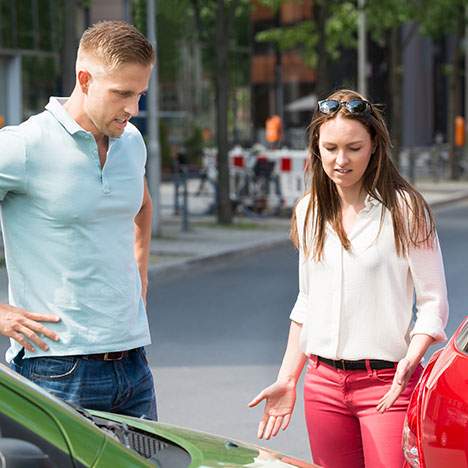Involved in a Not at Fault Car Accident?
Acting properly during a traffic accident is essential to avoid more injuries and keep the situation under control. What happens when you are not at fault – car accident injuries and damages are the same whether you caused the accident or not? Speak with an experienced attorney.Many things can cause a traffic accident: mechanical failures, stress, speeding or driver distractions. And while much has been said about how to prevent an accident, little has been written about what to do when these unfortunate events occur.
The International Red Cross has built an action list for those affected in a traffic accident to act quickly and correctly. It is called “Conduct PAS,” an acronym that summarizes three basic actions to be taken in this type of accident: protect, alert and rescue.
These actions can be taken by the driver of a car, passengers or witnesses to help those affected in a traffic accident while they try to reach for the necessary authorities and try to avoid a he said she said car accident.
To Protect:

Once the accident has happened, the first thing to do is to protect the people directly involved in the event. Stay at the scene; don’t just leave. Gather all the information you can, which will help with accident fault determination rules:
- Verifying that you do not have serious injuries that compromise your health, and if you do, seek medical attention as soon as possible.
- Check the health status of the other people injured in the accident.
- Turn on the vehicle’s emergency lights to inform others of the situation.
- Put on the asphalt the reflective cones or triangles 30 meters from the injured vehicle (front and back of the vehicle, if it is a street or double track road). The important thing is to avoid a new accident due to lack of signage.
- Check for leaks of oil, gasoline and other hazardous fluids.
To Alert:
After verifying and gathering all the information, you need to alert the police and the appropriate authorities about the incident. You can do this by:
- Calling the emergency hotline (#911) or, if applicable, the highway police.
- Contact your insurance company.
- Contact your lawyer.
Tell them exactly what happened, including the exact location of the accident (direction and signs of how to get to the place), how long it has been since it happened, whether there are people injured or deceased, etc. Since the accident was not directly fault, you might be eligible for compensation for being a victim, courtesy of the insurance company of whoever is to blame for the motor vehicle accident.
If you need more information about to fight a police report, a knowledgeable attorney like those at Avrek Law can help you determine the next steps to take.
To Help:
- Do not remove the injured from the automobile, unless there is immediate danger of a fire, explosion or other similar events. This should be done by nurses or experts in the management of injured people.
- Do not remove the helmet from a motorcycle rider injured in a traffic accident.
- If any of the injured are bleeding, put pressure on the wound with a towel or shirt.
- If the people involved are not seriously wounded, tell them to stay on the sidewalk and away from the traffic accident
- When the authorities arrive, tell them exactly how you helped the wounded and leave the accident scene if they ask you to.
The calmness and tranquility with which you manage the situation will determine your ability to help the people wounded and the effectiveness of the aid that you can provide. Follow these tips in case you find yourself involved in accident that wasn’t you fault. California roads can be very dangerous so be careful.
What Should I Do Legally After a Not at Fault Car Accident?
You may be wondering how long you need to wait to make a claim after the accident, well, in order to be compensated by an insurance company or a court judgment, negligence should generally be proven first. For immediate help contact Avrek Law for a Free consultation.
Negligence is a legal term meaning that someone has not acted reasonably, carefully and responsibly.
In the case of a car accident, negligence is evidenced in facts that derive from the police report, eyewitness testimony, expert testimony, and photographs and sketches of the scene of the accident.
To prove negligence means to show that:
- The carelessness of someone who caused the car accident.
- The car accident caused damage, and the guilty party has the responsibility to pay compensation for said damage.
- If more than one party involved in the accident is found to be guilty, liability may be distributed to negligent parties in accordance with the percentage of fault. This is called comparative negligence.

If the perpetrator or perpetrators of the accident that wasn’t your fault fit(s) in these three categories, then you should consider suing the other driver’s insurance company by beginning a lawsuit for compensation.
However, it is very important for you to be aware of your injury coverage; while liability coverage is the only type of auto insurance coverage you are required to have in California, there are several other types of coverage available that include:
- Comprehensive Coverage – This covers you against damages that may occur to your car that do not involve a traffic accident, such as damage related to theft.
- Collision Coverage – This covers against damage to your car that occurs as a result of a traffic collision such as an accident with another driver.
- Medical coverage and funeral services.
- Coverage for uninsured or underinsured drivers – According to the latest statistics of insurance rates from the California Department of Insurance (CDI), in 2004, 14.43% of drivers in California had no auto insurance. Coverage for uninsured or underinsured drivers can cover damage caused by these drivers.
- Coverage for rental cars.
- Coverage of trailers and labor.
Note: Adding coverage for all risk and crashes is generally optional in California. However, if your car is being financed, or rented, your credit or leasing company will require you to buy all-risk and collision insurance coverage.
What Happens to My Car Insurance After Accident
Your car insurance rates won’t automatically increase at renewal time just because you filed a claim under your own insurance policy for an accident that wasn’t your fault. Most state laws strictly prohibit insurers from raising premium rates for accidents in which the insured wasn’t at fault. But insurance companies have been known to dump policies.
Should I Hire a Lawyer For a Minor Car Accident?
It is wise to know your state’s prompt-payment law and every state is different. Every state’s unfair claims settlement rules will outline the time frame in which an insurer needs to issue a check for damages. Contact Avrek Law Firm today for immediate help and a free consultation on your case.
It is important to note that unfair claims settlement practices acts typically don’t offer the same rights to you if you are making a claim against another driver’s insurance company, as opposed to filing a claim with your own insurance. Know your rights and speak to Avrek Law’s personal injury attorney team to discuss any next steps you may need to take in a not at fault car accident.
